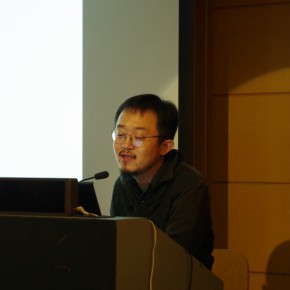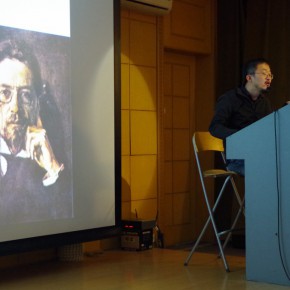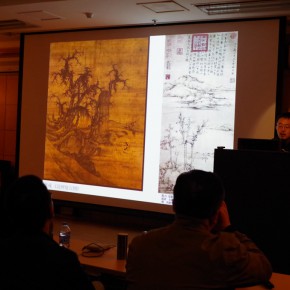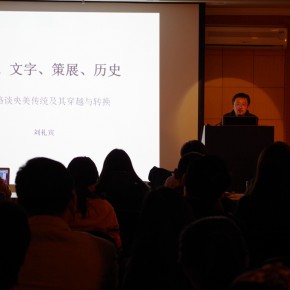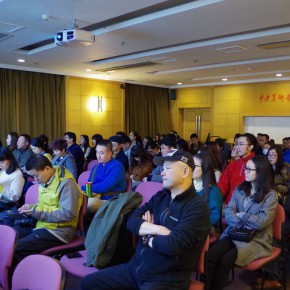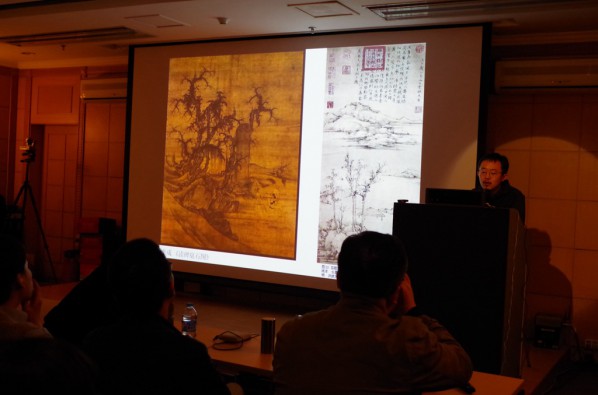
At 7:00 pm on April 10, 2015, CAFA “Entering the Library” lecture series 21: Visual, Text, Curating, History – On the Tradition, Traversing, and Transformation of CAFA” was held at the library lecture hall of CAFA, and the speaker was the art critic, curator Liu Libin, and Cao Qinghui, Deputy Director of the library of CAFA who presided over the lecture.
At the beginning of the lecture, Liu Libin initially talked about his roots in CAFA and his campus life, he joked that he had always been “an art lover”. Then Liu Libin took Li Cheng’s Reading Stele Nest Stone(Du Bei Ke Shi Tu) and Ni Zan’s Rongxi Studio as examples, to talk about the lack of feeling in the picture and visual ability, as well as the related training. Starting from Zong Bing’s saying of “lying to travel” to talk about how the body and work reacted with each other, he put forward the idea of the disadvantage of the visual symbolic interpretation of “only seeing the stones and trees” in contemporary Chinese art.
Liu Libin said we lost the ability to perceive works, and we got used to the interpretation by extracting meaning from the text. He said that, “In the face of works, what does interpretation mean? What is the essence of art for interpreters? Behind the impulse of interpretation, it is the structure of knowledge that inspires them to interpret desire. Whether art expresses the idea of the truth, kindness and the beautiful, or is it the expression of human nature, they all reveal the interests and theories of the interpreters. Without the reflection, the theory is not a new way to learn about artworks, but an instrumentalisation of a theory system.”
Subsequently, Liu Libin talked about the source of the criticism of consciousness, initially, it was the perception, including daily experiences, reading experiences and daily writing and artistic creations; secondly it was a judgment,which was more important than comment and curating; thirdly, it was the consciousness of the problem. Liu summarized his own three critical contexts: firstly, changing the criticism of visual painting to the exploration of Chinese abstract painting; secondly, from multiple levels to reflect the influence of the binary opposition of Chinese and Western thinking to Chinese art circles, he attempted to take “nothing” as the breakthrough, to cleanse the vulgar sociology haze that shrouds Chinese contemporary art; thirdly, reflection on the position of Chinese contemporary art: reflection and questioning, as well as the practical intervention. He hoped to reflect on the logical foundation of 30 years of Chinese contemporary art, referring to the present value of transcendent art and critical element of “things” in artworks once again, looking for a new construction of “subject”.
In the lecture, Liu Libin combined his curating experiences and the specific works of artists to offer a respective description of Chinese contemporary art ecology, considered as “language”, “main body”, “history” as the three key words of the 12 exhibitions planned by him in 2014, and he mentioned the three related groups of problems, which were badly in need of attention by Chinese contemporary art. In addition to several exhibitions continuing with the three questions, in 2015, he also opened some new clues, such as the exhibition“Spirit”, from a new perspective to explore the possibility of “subject construction”, offering a new dimension to contemporary art circles emphasizing “categorical meanings”.
Text and photo by Zhang Chi, Photo by Zhang Wenzhi/CAFA ART INFO
Translated by Chen Peihua and edited by Sue/CAFA ART INFO



